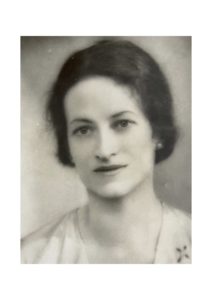
Sylvia Lynd’s work as a chief book critic for Time and Tide (1922-1929) sealed her reputation as a tastemaker and literary celebrity. Her parties have proved more enduringly famous than her poetry and fiction, although this was well received in its day: she was a strategic salonière, now best known for promoting the work of other writers, particularly women novelists, largely through the Book Society (founded in 1929) and as a book prize judge. Sylvia managed a close working partnership with her husband, the popular and prolific journalist and essayist Robert Lynd, Daily News/News Chronicle literary editor and a much-loved columnist (‘Y.Y.’) at Time and Tide’smain competitor, the New Statesman.
Lynd had an unconventional childhood even by the standards of Bohemian Hampstead, where she was born in 1888. She was brought up a feminist and an Irish nationalist by her Dublin-born mother N.F.Dryhurst (née Nannie Robinson). An anarchist and anti-imperialist activist in the circle around Peter Kropotkin (author of Mutual Aid, 1902), Dryhurst worked as a translator, journalist and educator. Like Lynd, she was a witty conversationalist and an energetic and effective networker, for whom friendship and work were intimately linked: their wisteria-clad home was filled with political and cultural radicals, fellow Irish nationalists, and exiled revolutionaries from France, Russia, Georgia, India and Egypt. Lynd’s father, A.R.Dryhurst, a British Museum administrator from a family with links to the Garretts and the Fawcetts, was one of the first Fabians. N.F. Dryhurst’s lover, the war correspondent Henry Nevinson, was a significant influence on Sylvia’s life, and even rumoured to be her biological father. Both Nevinson (an old friend of founding Time and Tide director Elizabeth Robins) and Lynd were members of the United Suffragists group.
Lynd’s only novels, The Chorus (1915) and The Swallow Dive (1921), explore the choices open to a young independent woman before WW1 and draw on her own early experiences in the creative arts. Following a progressive education at King Alfred’s School, The Slade (1904-6) and RADA (1908), she embarked on a brief acting career, which was truncated by marriage in 1909 to Robert Lynd, a Presbyterian Ulsterman and socialist. Robert and Sylvia had met in 1905 through the London Gaelic League, spoke Irish with their infant daughters (born 1910 and 1912), and, like N.F.Dryhurst, were early members of Sinn Féin and active in Irish nationalist circles.
Lynd’s reviews, short stories and closely observed lyrical poems appeared in The Nation, the New Statesman, the Weekly Westminster, The Bystander, and Harper’s Bazaar, among other publications, and her name and opinions were used on advertisements and even billboards to boost book and newspaper sales. Appointments in 1923 and 1928 to the committees for the Prix Femina Vie Heureuse Anglais (which she chaired in 1929 and 1938-9), and the Book Society, Britain’s first monthly book club, recognised and enhanced her status as an arbiter of intelligent middle-class taste.
Despite chronic bad health, repeated pregnancy losses, and a difficult marriage, Lynd continued to be productive and sociable, reviewing, judging, reading for publishers and also producing critical introductions, an anthology and, in 1942, a history of English Children. A late piece for Time and Tide before her death in 1952, ‘My Double Life: A Chapter of Autobiography’ (2 June 1948), was an amusing account of Sylvia Lynd’s ‘Astral Body’, which friends had spotted silently attending a weekend gathering in Brighton, a cricket match, and even an early committee meeting of the Book Society.
By Dr Lydia Syson. Lydia is Sylvia Lynd’s great granddaughter.
Selected Sylvia Lynd publications available online:
The Chorus: A Tale of Love and Folly (Constable & Co, 1915)
The Thrush and the Jay, (NY: Dutton & Co, 1917)
The Mulberry Bush, and other stories (first published 1923, reprinted 1970)
Collected Poems of Sylvia Lynd (London: Macmillan, 1945)
Sources
Clay, Catherine. Time and Tide: The Feminist and Cultural Politics of a Modern Magazine. Edinburgh: Edinburgh University Press, 2018.
Gaster, Maire. N.F.Dryhurst: Biographical Introduction [undated], NLI, MS 49,981/10 (Manuscripts Reading Room)
John, Angela. War, Journalism and the Shaping of the Twentieth Century: The Life and Times of Henry W. Nevinson, London, New York: I.B.Tauris, 2006.
Lynd, Sylvia. Diary of Sylvia Lynd, from 1935. UoR, MS 5585, box 1.
Lynd, Sylvia. Typescript of an autobiography by Sylvia Lynd, edited by her daughter Maire Gaster. UoR, MS 5585, box 2/A1 (1of 4).
Wilson, Nicola. ‘So now tell me what you think!’: Sylvia Lynd’s collaborative reading and reviewing – the collaborative work of an interwar middlewoman. Literature & History, 28 (1), 2019: 49-65.